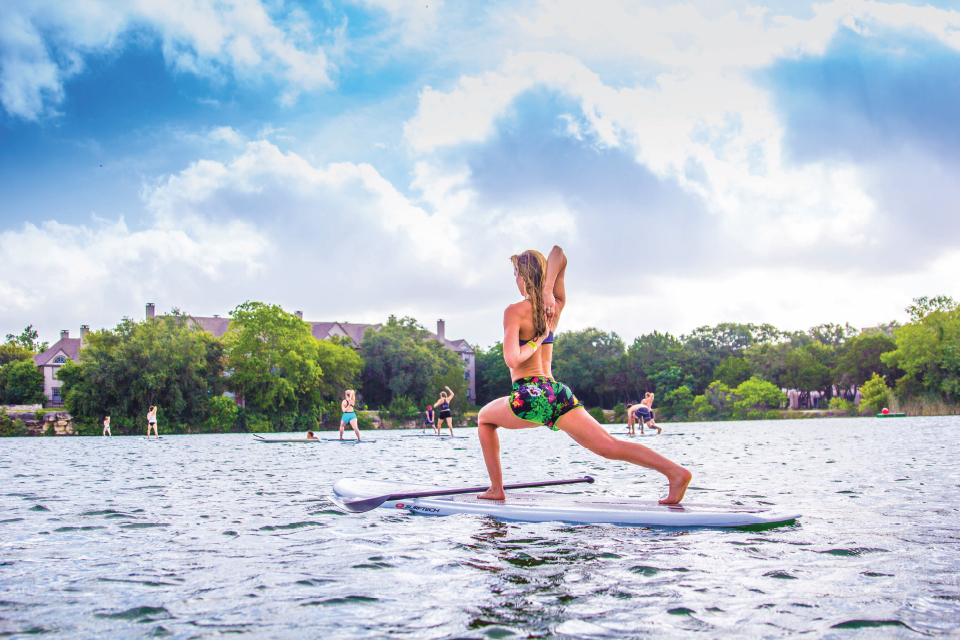SUP Yoga

I’m sure I’m not the only one to wake up in the morning with tight muscles following a tough day’s training, similar to the feeling of being hit with a hammer. I try to stretch out the soreness, but my range of movement is restricted, and my back spasms with every move. In dire need of a solution, I give flexibility training a try.
Before writing this, I was not too familiar with yoga as a form of training. To be honest, it was difficult for me to adopt, but the more I learn about yoga, the more I support the idea of including yoga as an essential form of training in addition to an exercise regime.
In my experience, restricted range of movement causes bad posture and a full catalog of injuries, including random back spasms, torn hamstrings, and lower back pain—all of which have put me out of training for months. Throughout the years, I’ve been given numerous pre- and post-workout stretches, but the routine can seem dull and minor in comparison to the rest of my training. I yearn for structure, focus, and a fun way to stay flexible in my workout routine.
Since moving to Austin, I wanted to continue maintaining a focus on flexibility, so I turned my attention toward yoga. Where better to start than Austin, Texas? This city is home to a variety of different yoga classes that are for all levels of ‘yogis,’ including a novice like myself. Two different yoga studios that caught my attention for different reasons were Black Swan Yoga and Pure Austin.
Black Swan Yoga is a nonprofit yoga group with four studios spread around Austin, providing online and in-person yoga classes. I admire their donation-based service, with supportive teachers who reduce barriers to yogis while taking part in a practice they love.
It was Black Swan’s partnership with Onnit Academy that initially caught my attention. Onnit recognizes yoga as a form of cross-training and incorporates yoga classes into their programs. Yoga classes run alongside mace-swinging, kettlebell-flinging, and barbell-lifting sessions with effective results achieved by those who participate.
I spend the majority of my time on the water in either a rowing boat, canoe, or stand-up paddleboard (SUP), so I leaped at the chance to join in with Pure Austin’s SUP yoga class. I was anxious and excited for this new, hybrid activity. It is enough of a challenge to get my 6-foot-6-inch frame into yoga positions on dry land, so balancing my body weight on a paddleboard looked more like Bambi on ice.
The instructor started us off easy with a simple cobra pose into a push-up, but as we transitioned through the warrior poses, it was only a matter of time before I plummeted head first into Quarry Lake.
When on the boards, you have an exaggerated sense of balance and awareness of your weight displacement; every muscle in the body is working to stay centred, which is much different from doing yoga on land, where your weight may naturally drift to one side of your body without consequence of submersion. SUP yoga requires skills relevant to every sport, such as breathing, balance and flexibility.
I approached this article with little experience in yoga but a great awareness of the importance of flexibility in sports. I always perceived yoga as a more challenging form of activity, and to watch yogis go through a cycle of exercises that seem impossible was discouraging. In addition, completing a series of stretches didn’t seem beneficial to the rest of my training. How could I develop in fitness if my lungs weren't burning and my legs didn’t sting with pain?
However, my perceptions have definitely changed. After speaking with fellow yogis and instructors, and trying yoga first-hand, I now see how flexibility sessions can be a fun and an effective form of cross-training. I encourage athletes to pick up a yoga mat (or paddleboard) and take part in one of the many yoga classes in Austin, even if it’s just one session per week.






